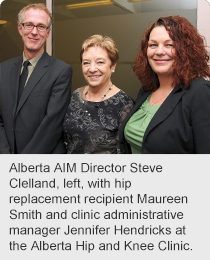
February 6, 2013
Story by Tara Grindle; Photo by Paul Rotzinger
Last summer, Maureen Smith learned she needed a new hip.
The 61-year-old Calgarian was pleasantly surprised when her pre-operative care was completed and surgery booked before Christmas.
Smith is one of about 2,200 patients who visit the Alberta Hip and Knee Clinic in Calgary every year. The surgeon-owned facility – the city’s busiest hip and knee clinic – recently slashed its wait times almost by half by participating in the wait-time reduction initiative Alberta AIM (Access. Improvement. Measures), jointly supported by Alberta Health Services (AHS) and other partners. 
“Everyone at the clinic was so amazing,” says Smith, “and I was really surprised by how quickly I was able to get in.”
In a one-year period, the wait time between referral to the clinic and initial consult has been reduced from five months to less than three months.
“The changes we’ve made have had a positive impact on how patients flow through the clinic, wait times and the quality of care we provide,” says Dr. Robert Korley, one of the clinic’s surgeons. “This means less frustration and better outcomes for our patients.”
Changes involved finding efficiencies in all parts of the clinic, from ensuring exam rooms are fully stocked with medical supplies so nurses don’t need to leave the room during appointments, to scheduling weekly appointments between the clinic’s case managers and clinicians on surgical units.
“That has really helped us all better understand the needs of the patients coming for surgery and what they’ll need at the clinic after they leave the hospital,” says Kyle Lang, manager of the orthopedics unit at the Peter Lougheed Centre.
Through AIM, the clinic also measured the time patients spent at their initial consult.
“We didn’t realize how much time was spent waiting to see the next provider,” says clinic administrative manager Jennifer Hendricks. “We were able to reduce the number of providers they see from four to three. We also made improvements in how the patients go through the clinic so we have the right person available for the required job at the right time.”
As a result, the average initial consult takes about three hours, nearly an hour shorter than before AIM, which has increased the number of consults available.
Changes such as those being made at the Alberta Hip and Knee Clinic are contributing to the steady decrease in overall provincial wait times for hip and knee surgeries.
Currently, 90 per cent of those waiting for a hip replacement will have their surgery within 35.2 weeks, down from 39.7 last year, an 11 per cent improvement; and 90 per cent of knee replacements are completed in 39.3 weeks, down from 49.9 weeks last year, a 21 per cent improvement.
Alberta AIM director Steve Clelland says a critical part of the improvement process is learning to measure and staying focused on the impact of changes made.
“AIM helps identify where and how improvements can be made but, more importantly, it teaches teams how to test a change and make sure it’s having a positive impact,” says Clelland. “That’s why we see such great results from participants like the Alberta Hip and Knee Clinic. They know where they started, what affect their changes have made and ultimately how far they have come.”
The Alberta Hip and Knee clinic is also supported by the Alberta Bone and Joint Health Institute (ABJHI), an independent organization that collects data across the province and standardizes care. The ABJHI helps the clinic verify its data and measure its success on an ongoing basis.
Alberta AIM is supported by AHS, the Alberta Medical Association, Alberta Health, Toward Optimized Practice, and the Primary Care Initiative, and is intended to help physicians and their teams increase access through improved efficiency.